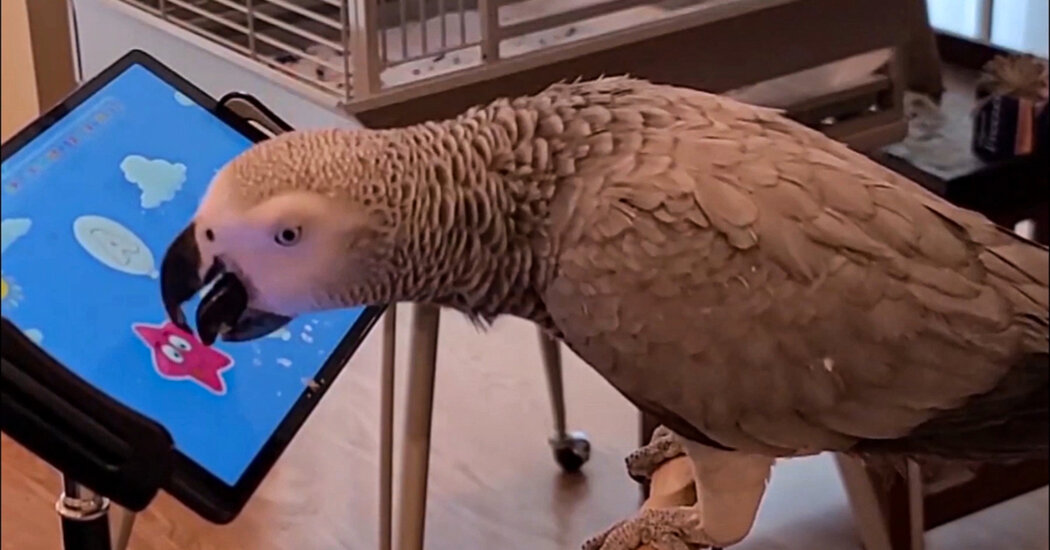Parrots have much in common with toddlers. The brainy birds can learn to recognize colors and shapes, manipulate objects, build large vocabularies and make their needs known at improbably high volumes. They are also playful, intelligent and curious; without ample cognitive enrichment, they quickly become bored.
So owners of pet parrots sometimes turn to a strategy familiar to parents: reaching for the closest available screen. And some owners have found that they can keep their birds occupied with mobile games, drawing apps and music-making programs designed for young children. “Kids apps are quite popular,” said Rébecca Kleinberger, a scientist at Northeastern University who studies how animals interact with technology.
But apps designed for humans may not be ideal for parrots, which tend to use their tongues to interact with touch screens. That results in a variety of unique touch behaviors, Dr. Kleinberger and her colleagues reported in a new study. (The research was a collaboration between Ilyena Hirskyj-Douglas, who directs the animal-computer interaction lab at the University of Glasgow, and scientists at Northeastern University. It has not yet been published in a peer-reviewed journal but will be presented at a conference in May.)
The results suggest mobile apps have potential as an enrichment tool for parrots, but they should be tailored to the birds’ specific biology.
“How do we make technology work for their unique bodies and their unique needs?” Dr. Kleinberger said.
To conduct the study, the scientists created a customized version of a mobile app designed to help researchers and designers collect information about how humans interact with touch screens. The app displayed a series of red circles; the birds’ task was to tap them as quickly and accurately as possible, while the app collected data on how the parrots touched the screen.
The owners of 20 pet parrots encouraged the birds to touch the circles by doling out treats. (In most cases, the rewards were edible — peanut butter, yogurt or pine nuts, for instance — but the birds had their own idiosyncratic preferences. “There was one bird who was not very food-motivated, and instead was most responsive to just cheering and praise,” Dr. Kleinberger said.)
Once the birds had the hang of the game, the researchers began collecting data on their performance and touch behaviors. The parrots were less accurate than humans, but performed well enough that it was clear they were not randomly tapping at the screen, the researchers found.
And the birds’ touch behaviors differed from those of humans in a variety of ways. For one, the parrots had a tendency to use their tongues to quickly and repeatedly hit the same target. Although the idea remains unproven, Dr. Kleinberger hypothesized that the behavior might be a byproduct of the way that parrots use rapid tongue movements to manipulate seeds.
The birds also used lighter pressure than human users, which meant that the software did not always register their taps, frustrating the birds, Dr. Kleinberger said. They also more often dragged their touches, moving their tongues across the screen before picking them up again. “It was really a lot of licking the screen,” Dr. Kleinberger said. Designers creating software specifically for parrots could use that knowledge to create a game that is “made to be licked,” she added.
The researchers also found that whereas humans tend to get faster when the targets are moved closer together, for the parrots there appeared to be a built-in lag between hitting the targets, even those close together. Video footage revealed that the birds tended to “tap and retreat,” touching the screen and then pulling back from it before homing in on the next target. The behavior makes sense given how close the eyes are to the tongue, Dr. Kleinberger said; the birds might need to pull back from the screen to recalibrate after hitting each target.
Many parrot owners reported that their birds appeared to enjoy using the app, although some birds seemed to lose interest over time. Dr. Kleinberger said she hoped that designing software specifically for parrots might help boost the birds’ engagement and enjoyment.
“A lot of research on animals and technology is about trying to understand: What can animals do?” Dr. Kleinberger said. “And what I always try to do is reframe the question to: What can we do for them?”
Source link

